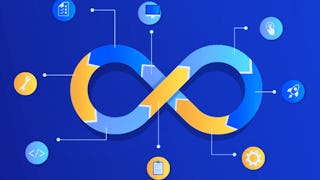This is the third course of the Exam Prep AZ-400: Microsoft DevOps Engineer Expert Specialization. This course focuses on how to create and manage package repositories to ensure effective dependency management and explore pipeline creation and testing strategies. Discover how to implement deployment strategies and utilize IaC for automating resource provisioning. Explore techniques for optimizing and maintaining pipelines to support continuous development and delivery processes.



Design and Implement Build and Release Pipelines
This course is part of Exam Prep AZ-400: Microsoft DevOps Engineer Expert Specialization

Instructor: Whizlabs Instructor
Included with 
Recommended experience
Details to know

Add to your LinkedIn profile
April 2025
6 assignments
See how employees at top companies are mastering in-demand skills

Build your subject-matter expertise
- Learn new concepts from industry experts
- Gain a foundational understanding of a subject or tool
- Develop job-relevant skills with hands-on projects
- Earn a shareable career certificate


Earn a career certificate
Add this credential to your LinkedIn profile, resume, or CV
Share it on social media and in your performance review

There are 2 modules in this course
This section provides a comprehensive overview of package management, including recommended tools and platforms like GitHub Packages registry and Azure Artifacts. It explores the concept of package feeds, offering insights into designing and implementing feeds and views for both local and upstream packages. The section also covers strategies for publishing packages effectively and emphasizes creating robust dependency versioning strategies using semantic versioning (SemVer) or date-based versioning (CalVer). Additionally, it delves into artifact versioning and outlines the design and implementation of pipeline artifact versioning strategies to ensure consistent and reliable workflows
What's included
16 videos2 readings3 assignments
This section provides a comprehensive overview of package management, including recommended tools and platforms like GitHub Packages registry and Azure Artifacts. It explores the concept of package feeds, offering insights into designing and implementing feeds and views for both local and upstream packages. The section also covers strategies for publishing packages effectively and emphasizes creating robust dependency versioning strategies using semantic versioning (SemVer) or date-based versioning (CalVer). Additionally, it delves into artifact versioning and outlines the design and implementation of pipeline artifact versioning strategies to ensure consistent and reliable workflows
What's included
17 videos2 readings3 assignments
Instructor

Offered by
Explore more from Software Development
Why people choose Coursera for their career




New to Software Development? Start here.

Open new doors with Coursera Plus
Unlimited access to 10,000+ world-class courses, hands-on projects, and job-ready certificate programs - all included in your subscription
Advance your career with an online degree
Earn a degree from world-class universities - 100% online
Join over 3,400 global companies that choose Coursera for Business
Upskill your employees to excel in the digital economy
Frequently asked questions
Access to lectures and assignments depends on your type of enrollment. If you take a course in audit mode, you will be able to see most course materials for free. To access graded assignments and to earn a Certificate, you will need to purchase the Certificate experience, during or after your audit. If you don't see the audit option:
The course may not offer an audit option. You can try a Free Trial instead, or apply for Financial Aid.
The course may offer 'Full Course, No Certificate' instead. This option lets you see all course materials, submit required assessments, and get a final grade. This also means that you will not be able to purchase a Certificate experience.
When you enroll in the course, you get access to all of the courses in the Specialization, and you earn a certificate when you complete the work. Your electronic Certificate will be added to your Accomplishments page - from there, you can print your Certificate or add it to your LinkedIn profile. If you only want to read and view the course content, you can audit the course for free.
If you subscribed, you get a 7-day free trial during which you can cancel at no penalty. After that, we don’t give refunds, but you can cancel your subscription at any time. See our full refund policy.
More questions
Financial aid available,




